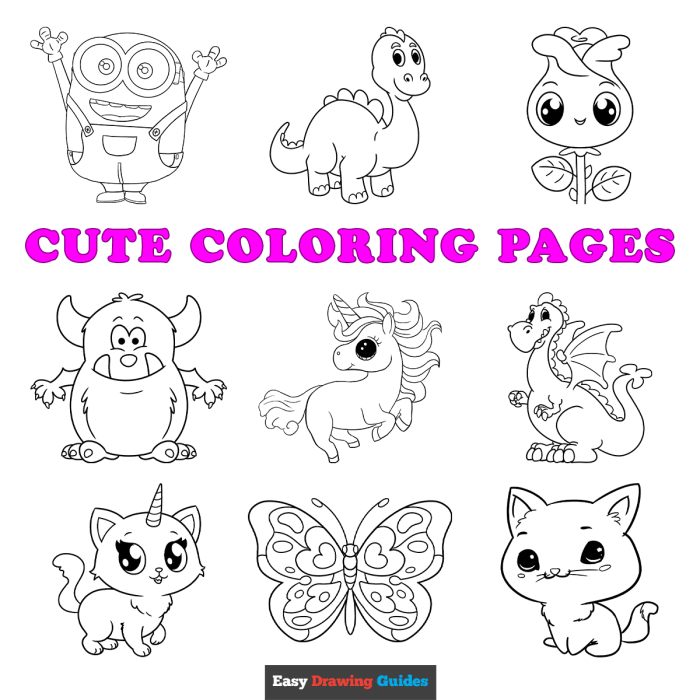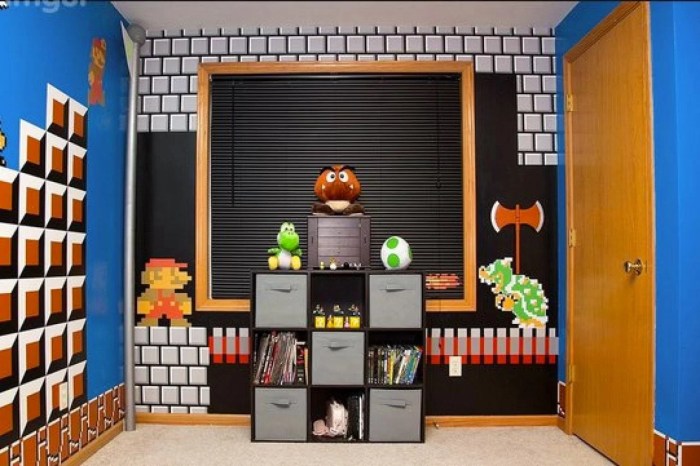Coloring Techniques and Methods for Kids: Coloring Ideas For Kids

Coloring ideas for kids – Coloring is a valuable activity for children, fostering creativity, fine motor skill development, and hand-eye coordination. Different techniques cater to varying age groups and skill levels, allowing for progressive learning and artistic expression. This section details several coloring techniques and methods, illustrating how different tools can be used to achieve diverse effects.
Basic Coloring Techniques for Young Children
Young children often benefit from simple techniques that emphasize exploration and self-expression. Scribbling, basic shading, and outlining are excellent starting points. Scribbling allows for freeform exploration of color and movement. Basic shading involves applying color more heavily in some areas to create a sense of depth or form, even if rudimentary. Outlining involves coloring within pre-defined shapes, improving fine motor skills and staying within boundaries.
These techniques build foundational skills for more advanced methods.
Advanced Coloring Techniques for Older Children
As children develop, they can explore more nuanced techniques that enhance their artistic capabilities. Blending involves smoothly transitioning between colors to create gradients and subtle shifts in tone. This requires more control and precision. Layering colors involves applying one color over another, allowing the underlying color to subtly influence the final result, creating depth and complexity. This technique can also be used to create interesting textural effects.
Utilizing Different Coloring Tools, Coloring ideas for kids
The choice of coloring tool significantly impacts the final outcome. Different tools offer unique textures and capabilities.
- Crayons: Crayons are ideal for young children due to their large size and ease of use. They produce bold, opaque colors and are suitable for layering. Applying pressure varies the intensity of the color, allowing for simple shading effects. Layering multiple crayon colors can produce unique mixed shades.
- Markers: Markers offer vibrant, intense colors and are great for filling in large areas quickly. Fine-tipped markers allow for more precise work and detail. Water-based markers can be blended easily by layering wet-on-wet, while permanent markers provide sharp lines and are less prone to smudging.
- Colored Pencils: Colored pencils provide a wider range of control and allow for finer details. They can be layered to create subtle shading and depth, and pressure control affects color intensity. Blending with colorless blending pencils can soften harsh lines and create smooth transitions.
Color Mixing for Enhanced Effects
Color mixing expands the range of available colors and allows for more creative expression. Mixing primary colors (red, yellow, blue) produces secondary colors (orange, green, purple). Mixing these secondary colors, or mixing secondary colors with primary colors, creates a wide spectrum of tertiary colors.
- Ocean Theme: Combining shades of blue (primary) with green (secondary) and hints of white creates a realistic ocean scene. Adding darker blues and greens can create depth.
- Sunset Theme: Blending oranges (secondary), yellows (primary), and reds (primary) produces a vibrant sunset. Adding touches of purple (secondary) and pink (tertiary) can enhance the effect.
- Forest Theme: Various shades of green (secondary) can be created by mixing different amounts of blue and yellow. Adding brown (tertiary, created by mixing red, yellow, and blue) adds depth and realism.
Creative Coloring Projects and Activities

Engaging children in creative coloring projects fosters imagination, fine motor skills development, and color recognition. These activities provide opportunities for self-expression and exploration of different artistic techniques. The following examples demonstrate how coloring can be transformed into enriching and educational experiences.
Designing a Personalized Superhero Character
This activity encourages children to develop their own unique superhero. Begin by brainstorming superhero characteristics: powers, costumes, and personalities. Children can then sketch their superhero on a blank piece of paper, paying attention to details like the costume’s design, facial features, and any special accessories. Following the sketch, children can use coloring pencils, crayons, or markers to bring their superhero to life, experimenting with different colors and shading techniques to enhance the character’s appearance.
The finished product represents a personalized creation, reflecting the child’s individuality and imagination.
Creating a Simple Landscape Scene
A simple landscape scene provides a framework for exploring color mixing and perspective. The project begins with a basic Artikel of a landscape, including elements like a sun, a house, trees, and possibly a small hill or river. Children can then choose colors to represent these elements, experimenting with shades and tints to create depth and realism. For instance, the sun might be a bright yellow, while the trees could utilize varying shades of green and brown.
The house could be a cheerful red or blue, depending on the child’s preference. This project allows children to practice their color coordination skills while developing their understanding of basic landscape composition.
Coloring a Favorite Animal with Added Details and Textures
Focusing on a favorite animal allows children to express their affection while developing artistic skills. Select a simple Artikel of an animal—a cat, dog, bird, or any other animal of their choosing. Encourage the child to go beyond basic coloring. Introduce concepts like shading to create a sense of depth and form. For example, darker shades can be used to create shadows under the animal’s belly or behind its legs.
Different textures can be simulated using various coloring techniques; short, quick strokes might represent fur, while longer, smoother strokes could depict scales or feathers. The resulting colored image is more than just a picture; it’s a detailed representation of their beloved animal.
Exploring coloring ideas for kids can unlock a world of creativity and cognitive development. Studies show that the act of coloring improves fine motor skills and hand-eye coordination. For readily available options, consider checking out websites like little kid coloring pages which offer a vast selection of designs. These resources provide a fantastic starting point for sparking imagination and enriching the coloring experience for young children, leading to more advanced coloring ideas later on.
Using Coloring Pages to Teach Basic Concepts
Coloring pages can be effectively utilized as educational tools. Simple shapes can be colored to reinforce shape recognition. Numbered sections on a coloring page can be colored according to a color key, introducing basic number association. Different colored objects can be used to teach color names and basic color mixing concepts. For instance, a coloring page featuring different colored fruits can be used to teach children the names of different fruits and their associated colors.
Similarly, a page with numbered sections, each requiring a specific color, introduces the concept of matching numbers with actions. This multi-sensory approach enhances learning through visual and kinesthetic engagement.
Coloring Page Design and Illustration Ideas
Designing engaging coloring pages requires careful consideration of theme, detail, and age appropriateness. The following examples illustrate diverse approaches to creating captivating coloring page designs for children. Each design incorporates elements that stimulate creativity and provide opportunities for personalized expression.
Underwater Scene Coloring Page Design
This coloring page depicts a vibrant coral reef teeming with marine life. The central focus could be a large, friendly-looking whale, surrounded by smaller fish of various shapes, sizes, and colors. Sea anemones in bright hues, playful dolphins leaping from the water, and a playful octopus hiding amongst the coral add visual interest. The background could feature gently swaying seaweed and a sunlit surface, creating a sense of depth and tranquility.
The level of detail can be adjusted to suit different age groups, with younger children benefiting from simpler shapes and larger areas to color, while older children can enjoy more intricate details, such as scales on the fish or textures within the coral.
Whimsical Forest Scene Coloring Page Design
This coloring page showcases a magical forest brimming with fantastical elements. A family of fairies, each with unique attire and delicate wings, could be central to the design. They could be interacting with various magical creatures, such as a tiny dragon with iridescent scales, a mischievous pixie perched on a mushroom, and a wise old owl nestled in a hollow tree.
The trees themselves could be styled whimsically, with twisting branches and luminous leaves. Flowers in a variety of shapes and colors could add further vibrancy. Paths winding through the forest could provide additional opportunities for creative coloring. The overall style should be lighthearted and playful, encouraging imaginative coloring choices.
Vibrant Cityscape Coloring Page Design
This coloring page presents a bustling cityscape filled with architectural variety and transportation. Tall skyscrapers with distinct architectural styles could dominate the background, while smaller buildings, such as shops and houses, populate the foreground. Various vehicles, including buses, cars, taxis, and even airplanes overhead, add dynamism to the scene. The cityscape could incorporate recognizable landmarks or be a more abstract representation of a city.
Children can color the buildings in bright, contrasting colors, adding details such as windows, doors, and streetlights. The inclusion of people walking or interacting adds a sense of life and activity to the scene.
Christmas-Themed Coloring Page Design
This coloring page features a classic Christmas scene. A cozy, snow-covered house could be the central element, with smoke curling from the chimney. A Christmas tree adorned with colorful ornaments and twinkling lights stands prominently in the front yard. Friendly snowmen, playful reindeer, and Santa Claus himself could be incorporated into the design. The background could include falling snowflakes, creating a festive winter atmosphere.
Color suggestions include warm reds and greens for the house and tree, contrasting with the cool blues and whites of the snow. Children can add their own creative touches by coloring the ornaments and other details with a variety of festive shades.
FAQ Corner
What are some good coloring pages for toddlers?
Simple shapes like circles, squares, and basic animals in bold, bright colors are ideal for toddlers. Large areas for coloring allow for easy filling and encourage exploration.
How can I make coloring more engaging for my child?
Try themed coloring sessions (e.g., “ocean week”), use different coloring tools (crayons, markers, paint), and incorporate storytelling around the pictures. Collaborate on a coloring project together!
Are there any benefits to using digital coloring apps?
Digital coloring apps offer convenience, a wider range of colors and tools, and the ability to easily undo mistakes. They can also be a good alternative for children with fine motor skill challenges.
My child gets frustrated with coloring. What can I do?
Start with simpler designs, offer positive encouragement, and focus on the process rather than the perfect outcome. Take breaks and try different coloring tools to see what your child prefers.



